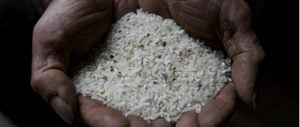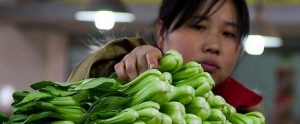Editor’s note: last week, environmental campaign group Greenpeace released a statement saying it had identified banned, and highly toxic, pesticides on vegetables being sold in three supermarket chains in China – Lotus, Lianhua and British retail giant Tesco. Banned pesticides are not the only problem: the following Xinhua report, reproduced in full, shows how market pressures on small-hold farmers and a lack of adequate testing by authorities mean misuse of legal pesticides also poses a threat to public health in China.
String beans, aubergines, Chinese cabbage: these vegetables are the commonest of sights on a Chinese dining table. But they aren’t grown with sunlight and rainwater alone – chemicals are lavished on them throughout their lifespan.
This summer, Xinhua Viewpoint tracked vegetables from the fields of Anhui province, east China, to dining tables in Chinese homes. We saw string beans being “fed” 11 types of chemical, and aubergines being doused with four different kinds of pesticide – the day before being carried off to the market for sale. We also identified three points in the process where testing for contamination should happen, but vegetables are passing through unchecked. The authorities,
meanwhile, say they cannot do anything to fix the problems.
“It’s tough growing vegetables nowadays – you’re always applying chemicals; they all need them,” 66-year-old Wang Mingcheng told us as he sprayed pesticide on his string beans. He had applied chemicals to his crop almost every day that month – necessary, he said, if he wants to make any money.
His family has three and a half mu (around 2,300 square metres) of land where they plant string beans. They start planting in early April, and by the time we were speaking to him – late summer – were close to taking their crop to market. At a nearby ditch, we counted containers for 11 different types of chemical: seven insecticides, such as cyfluthrin and cyhalothrin, three fungicides, including dufulin, and one miticide, pyridaben.
Some crops are treated daily and picked before completion of the harvest interval – a period of time between application of pesticide and harvesting the crop, to allow chemical levels to subside to safe levels. Zhang Tianbao, a farmer from Lujiang, explained that Chinese cabbage is particularly vulnerable to pests and disease, especially in summer. The trader he buys his pesticides from advises him to apply the spray once every few days and not to pick the crop too soon after application – but when Zhang sees the pests, he can’t just leave them to it, and so ends up using the spray almost every day. “Sometimes we use the pesticides one day and pick the crop the next,” he told us, helplessly.
The farmers also decide dosages for themselves. When Dai Jixia of Hexian noticed pest damage on the leaves of her aubergines, she mixed up four different types of pesticide, including bifenthrin and methylamino abamectin, and applied them all at once to save time. “We’re just making it up as we go along,” she explained. “They’re all going on anyway, so we might as well do it all at once.”
The farmers don’t think anything of using chemicals on vegetables they’re not intended for. Wang Mingcheng uses pesticide registered for tomatoes, tobacco and apple trees on his string beans. One of the chemicals Dai Jixia applies to her aubergines is listed as a product for wild cabbage, tomatoes and tea bushes.
A farmer in Hebei named Tang said that when he found insects in his string beans, the pesticide merchant sold him cyhalothrin. Noticing that it was only listed for use on cotton, Tang asked the merchant if it was alright to use on his crop – and was told it could be applied to anything.
The farmers “have no choice” but to use the chemicals, they say. “One round of pesticide costs about 40 yuan – so far I’ve spent 1,500 yuan [US$235] on chemicals alone, which is more than I’ll make selling my aubergines,” lamented Dai Jixia. She said nobody would use the pesticides if it wasn’t for disease and pests: if you don’t use chemicals, your harvest is smaller and you might even make a loss. If the farmers were given more guidance, they wouldn’t use the chemicals so freely, she added – nobody wants to waste money.
Is anything done to ensure that these vegetables – plied with these “compulsory” pesticides – are safe to eat? We tracked a batch from the field in Hexian to the market in Ma’anshan to find out.
On August 2, we visited Dai Jixia’s fields and learned that, the previous day, she had applied a mixture of four types of chemicals to her aubergines to kill off pests. She picked her crop early on August 3. The bag containing the bifenthrin she had used stated that it was meant for tea bushes and tomatoes, with respective safety intervals of seven and four days between application and harvest.
“Strictly speaking, using chemicals on crops other than those intended carries safety risks,” said Duan Jinsheng, director of the testing laboratory at Anhui Academy of Agricultural Sciences’ crop safety institute, adding that it is dangerous to harvest vegetables before the safety interval is over.
So would these aubergines – treated with chemicals that shouldn’t have been used, and picked before the harvest interval was over – be tested on their way to the table? We followed their trail through three stages:
Stage one: farmer to local wholesale market. Early on the morning of the August 3, Dai Jixia and her husband loaded several baskets of newly picked aubergines onto their tractor and drove to Buji vegetable wholesale market. There they sold their crop to a merchant named Cao, who was about to head to Ma’anshan. No testing was carried out.
Stage two: local wholesale market to city wholesale market. At dawn on August 4, Cao delivered a load of aubergines to Ma’anshan agricultural wholesale market. This is the second largest agricultural market in Anhui. Again, there was no testing
Stage three: city wholesale market to retail market: Early on August 4, stall-holder Wu bought 25 jin’s worth (about 12.5 kilograms) of Cao’s aubergines and took them to Xiangyuan market to sell to the public. There was still no testing.
Dai Jixia’s aubergines had travelled for 30 hours, from farm to local wholesale market to city wholesale market to retail market – with no testing at all, following a smooth path to the consumer’s dining table.
In Hexian county alone, around 480,000 mu (320 square kilometres) of land is planted with vegetables, mostly by small-hold farmers, according to He Nengzhong, director of the local agricultural committee’s vegetable office. Many of the farmers don’t know how often to use chemicals, or in what dose, or that it is important to respect harvest intervals. But, said He, local officials can neither identify the problems, nor do anything about them.
A tonne of vegetables is sold at the local wholesale market every day. “We don’t have testing equipment – we’re lucky if the county authorities come to test the food once or twice a year,” explained one market official.
Yao Yudong, deputy director of Ma’anshan agriculture committee said that 60% or more of vegetables sold in Ma’anshan comes from outside the city. The largest market, Anmin wholesale market, sells almost 1,000 tonnes of vegetables a day on average. Forty samples are tested daily, but this is just a drop in the ocean – even if the samples pass the tests, that doesn’t mean all the vegetables are safe.
The retail market lets everything from Anmin market through. Cai Futing, an employee at Xiangyuan market management office said “about 90% of the vegetables we sell come from Anmin. I’ve heard they’re very strict about testing, so we don’t test any of those here.”
Zhou Qingjie is a consultant to the Ministry of Commerce and director of the Economic Research Centre at Beijing Technology and Business University. He said that China’s vegetables are mainly grown by small-scale farmers, meaning use of crop-growing technology relies on experience, and quality-control relies on instinct – ultimately leading to more fertiliser being applied to increase yields, and more chemicals to control disease and pests. That’s the driver behind the cultivation of low-quality and unsafe vegetables, he said. Also, individual farmers struggle to invest in training and there is a lack of basic safety knowledge and sense of social responsibility, which only makes these problems worse.
An Yufa, head of the Centre for Agricultural Products Circulation and Marketing at China Agricultural University, said China’s failure to properly control contamination of food by agricultural chemicals was linked to inadequate safety testing during farming and sales.
Generally, testing should be done on every batch, he said, but when batches are coming in from thousands of farmers, this is a challenging task. Testing “drops in the ocean” is ineffective, and so spot-checks once the products have left the farm will be useless unless controls are first improved at the source.
Ge Rujiang and Jiang Gang are Xinhua reporters.
This article was originally published by xinhuanet.com. It is reproduced here with permission.
Homepage image by Stephan




